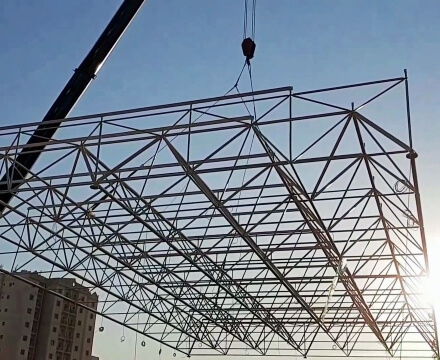Dapeng Town Industrial Park, Tongshan District, Xuzhou City, Jiangsu Province, China
The construction safety management of steel structure space frame engineering is a branch of construction safety management of construction projects, and it is also a complex project. All members are required to participate, and comprehensive governance must be strengthened. In the work, as a construction manager, we must take safety measures, improve various safety production systems, establish a safety production management mechanism, and increase the construction safety factor. Safety education and publicity work for all entrants should be done. It is mainly for prevention and safety first.
Let the space frame construction staff consciously abide by the security rules and implement safety measures to achieve no harm to others while not harming others. In actual engineering projects, the characteristics of network frame engineering projects need to be combined to further refine the work in management. With a rigorous scientific attitude, continuously studying and accumulating experience can be continuously completed and safely completed the construction tasks.
Steel structure space frame is a flexible structure and is light and light. Therefore, it can effectively reduce the impact of earthquake response and disasters, which is very conducive to earthquake resistance. In a multi -earthquake -zone country, the application of steel structures should be promoted in the earthquake areas, which can greatly reduce earthquake disasters and casualties. At present, light steel structured building have been officially launched.

To strengthen the safety management of steel structure space frame construction, here are some important measures and considerations:
1. Planning and Design:
Engage experienced and qualified structural engineers and architects for the planning and design phase.
Ensure compliance with relevant building codes, standards, and regulations.
Conduct a thorough structural analysis to ensure the stability and integrity of the space frame design.
Consider factors such as load capacity, wind and seismic forces, fire resistance, and maintenance requirements.
2. Quality Control:
Implement a comprehensive quality control system to ensure that all materials and components used in the construction meet the required standards.
Regularly inspect and test the steel materials for strength, durability, and corrosion resistance.
Verify the fabrication and welding processes to ensure they comply with industry standards and specifications.
Conduct non-destructive testing (NDT) methods such as ultrasonic testing and magnetic particle inspection to detect any hidden defects.
3. Construction Process:
Employ skilled and trained workers who have experience in steel structure construction.
Provide appropriate personal protective equipment (PPE) to all workers and ensure its proper usage.
Conduct regular safety training and awareness programs for workers to mitigate hazards and promote safe working practices.
Implement a strict site supervision system to monitor construction activities and ensure compliance with safety guidelines.
Conduct regular inspections and audits throughout the construction process to identify and address any safety concerns.
4. Risk Assessment and Management:
Perform a comprehensive risk assessment before and during construction to identify potential hazards and develop mitigation strategies.
Develop an emergency response plan and ensure that all workers are familiar with the procedures to follow in case of an emergency.
Install proper signage, safety barriers, and protective measures to prevent falls, trips, and other accidents.
Implement a permit-to-work system to control high-risk activities and ensure that they are carried out safely.
5. Documentation and Record-Keeping:
Maintain accurate documentation of all design plans, construction drawings, permits, and approvals.
Keep records of material certifications, inspections, tests, and any modifications made during construction.
Document safety training sessions, incident reports, and near-miss incidents for future reference and continuous improvement.
6. Regular Maintenance and Inspections:
Develop a maintenance schedule to regularly inspect and maintain the space frame structure after construction.
Monitor the structure for signs of corrosion, fatigue, or structural degradation, and take appropriate actions to address any issues promptly.
Conduct periodic inspections by qualified professionals to assess the overall safety and structural integrity of the space frame.
By implementing these measures and ensuring strict adherence to safety protocols throughout the construction process, the safety management of steel structure space frame construction can be significantly strengthened, reducing the risk of accidents and ensuring the long-term stability and integrity of the structure.